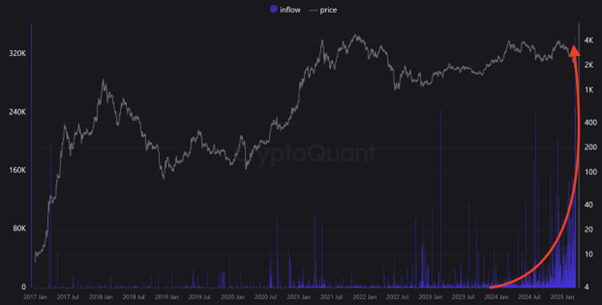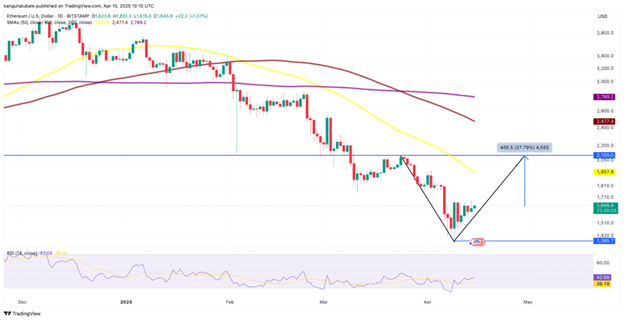A bullish performance in XRP followed Ethereum co-founder Vitalik Buterin’s recent comments that future hard fork upgrades to the blockchain network could be faster as the looming Spectra upgrade is set for early May.
Top Forex Brokers
Vitalik Buterin Signals Accelerated Ethereum Upgrade Timeline
Ethereum co-founder Vitalik Buterin hinted at faster future hard fork upgrades for the network following the Pectra upgrade slated for May 7, 2025.
While responding to an April 13 post on X, Buterin noted "near-zero pushback" on accelerating upgrades post-Pectra, signaling a shift toward more agile development for Ethereum.
“I'm seeing a lot of willingness to do faster hard forks post-pectra with near-zero pushback," Buterin wrote, referencing the upcoming Pectra upgrade for Ethereum.
Pectra will introduce account abstraction, raise staking limits, and boost rollup capacity with higher blob counts, marking Ethereum's largest update since Dencun in March 2024.
Buterin also shared some details about the Glamsterdam upgrade, which will follow Pectra and Fusaka, and aims to include gas limit increases and other scalability enhancements, according to Ethereum's roadmap.
“From where I'm standing, there's basically universal agreement among researchers that gas limit increase features are a top priority for Glamsterdam," Buterin wrote, adding:
“If the functionality is done sooner than Amsterdam, then Amsterdam itself can happen 'sooner than Amsterdam.'"
Buterin's comments come amid a record SOL-to-ETH price ratio, with Solana outperforming Ethereum, adding pressure to improve Ethereum's network efficiency.
Faster upgrades could help Ethereum address user growth concerns, a key issue highlighted in recent community discussions on X.
Reducing ETH Supply on Exchanges Backs Ether’s Upside
One factor supporting Ether’s potential to reclaim the $2,000 psychological level today is reducing supply on exchanges, as per data from CryptoQuant.
ETH balance on exchanges reached a 9-year low of 18.3 million ETH on April 4 after dropping nearly 3% year-to-date. These are levels last seen in July 2016 when ETH was trading below $15.
The chart below shows that this metric, which tracks the amount of ETH flowing into known exchange wallets, has declined sharply since October 2023, when withdrawals from the trading platforms began to surge.

A decline in exchange supply suggests that holders are moving their ETH into cold storage or staking, reducing the circulating supply available for trading.
Additional data indicates that crypto whales are quietly accumulating ETH in anticipation of a significant upward move. ETH inflows into accumulation addresses have surged to multi-year highs, surpassing levels seen before major bull runs, as seen in the chart below.
Ethereum accumulation addresses are a specific classification of wallet addresses used to track long-term holding behavior in the Ethereum network.
These addresses usually have no outgoing transactions, meaning the ETH is not used for spending, or is transferred out.

High inflows into accumulation addresses suggest that institutional investors and large holders are potentially taking advantage of ETH’s low price to add to their holdings in anticipation of a rise in Ether’s price.
ETH Price Nurtures a V-Shaped Recovery
Ether’s price action has been nurturing a V-shaped recovery chart pattern on the daily chart since March 25, as shown below.
A V-shaped recovery is a bullish pattern formed when an asset experiences a sharp price increase after a steep decline. It is completed when the price moves up to the resistance at the top of the V formation, also known as the neckline.
ETH appears to be on a similar trajectory and now trades below a supply-demand zone between the $1,800 psychological level and $1,937, where the 50-day simple moving average (SMA) currently sits.
This suggests that bulls need to push the price above this area in order to increase the chances of the price rising to the neckline at $2,100 to complete the V-shaped pattern. This would represent a 23% increase from the current price.

The relative strength index has increased from oversold conditions, at 24 on April 8, to 42 at the time of writing, suggesting that the bullish momentum is picking up.
Conversely, failure to hold above the immediate support level at $1,500 would see the price drop lower first toward the $1,400 psychological level and later the four-month low at $1,385, reached on April 9.
Ready to trade our daily analysis? Here’s our list of the best MT4 crypto brokers worth reviewing.
